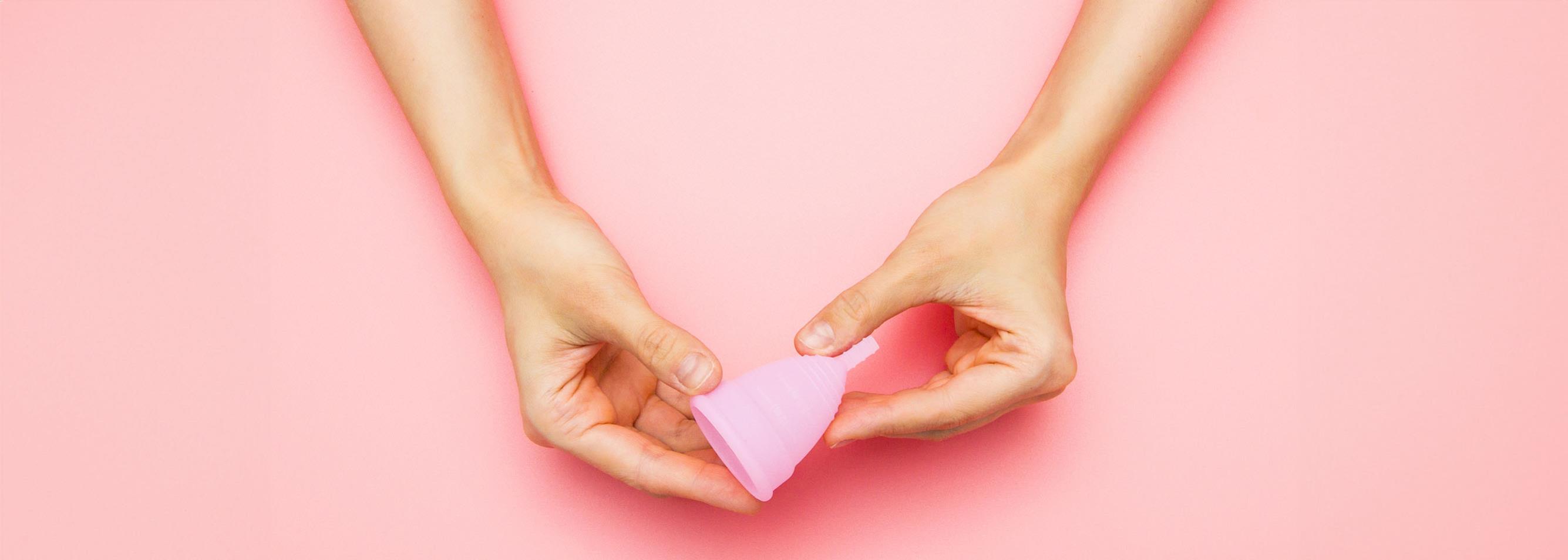Topics
What Are Menstrual Cups?
Menstrual cups are small, bell-shaped devices that are inserted into the vagina to collect menstrual blood rather than absorb it. They are made of flexible materials such as medical-grade silicone or rubber and can be reused for several years, making them cost-effective.
Menstrual cups come in different sizes, so users should choose one that is comfortable and suits their flow.
Here are some factors to consider when choosing the right cup for yourself:
- The capacity of the cup.
- Cervix height.
- Heaviness of flow.
- Material and flexibility of the cup.
- Size of cup (larger cups are recommended for women who have given birth).
- Budget.
How to Use a Menstrual Cup?
If you are new to using menstrual cups, getting the hang of it can take some time. Here is a step-by-step guide on how to use a menstrual cup:
What should you do before inserting the menstrual cup?
- Wash your hands thoroughly with soap and water.
- Before the first use and between uses, clean your menstrual cup. You can do this by boiling it in water for a few minutes or rinsing it in warm water, following the manufacturer's instructions.
- The cup must be clean and dry before insertion.
How to insert a menstrual cup?
- Find a comfortable position: You can stand with one leg up on the toilet seat, sit on the toilet or even squat on the floor.
- Fold the cup: Menstrual cups are designed to be folded before insertion. There are different folding techniques, such as the “C-fold”, “U-fold” or “7-fold”. Pinch the sides of the cup together and fold it in half, forming a C or U shape.
- Insert the menstrual cup: It is essential to relax your pelvic muscles to make insertion easier. Hold the folded cup with one hand and use the other hand to open the labia. Gently insert the cup into the vagina, aiming it towards the back and slightly upward. Once inside, let the cup unfold. It is recommended that the stem's bottom should be within half an inch from your vaginal opening.
- Check the seal: the cup is inserted, use your fingers to check if it has opened fully and formed a seal. Gently rotate the cup to ensure the cup is sealed properly. A slight suction sensation should be felt.
How to remove a menstrual cup?
- Wash your hands thoroughly with soap and water.
- Find a comfortable position. Some users find squatting comfortable, while others prefer sitting on the toilet or standing with one leg on the bathtub/toilet seat.
- Relax the vaginal muscles by taking a few deep breaths.
- Gently squeeze/pinch the base of the cup with the thumb and forefinger to release the suction seal.
- Once the seal is released, gently pull the cup out of the vagina. Make sure to keep the cup upright to avoid spilling the contents.
- Empty the cup's contents into the toilet or sink. Wash the cup well with mild soap and warm water before reinserting it.
Always check the cup for any signs of wear and tear, such as discolouration or cracks. If the cup is damaged, replace it immediately.
How Do I Know if My Menstrual Cup Is Full?
Menstrual cups can be worn for up to 12 hours, but the cup may need to be emptied more frequently on days with a heavier flow. Here are some signs that can indicate a full cup:
- Pressure against your vaginal walls due to the heaviness of a full cup.
- Light leakage after a few hours of wearing the cup.
- The cup feels like it is slipping down.
- Some people experience increased cramping or discomfort when the cup is full. It may be an indicator if you suddenly feel more pressure or discomfort.
Although menstrual cups have a larger capacity than pads or tampons, it can be tricky knowing when they are full, so you may need to experiment during the first few cycles to find the right timing.
Why Do Menstrual Cups Leak?
Menstrual fluid leakage whilst using cups is reported to be lower or similar to pads and tampons. However, the risk of leaks can be avoided with proper measures.
Here are some reasons why menstrual cups may leak:
- Incorrect insertion: If the cup is not inserted correctly, it may not create a seal and may leak. Ensuring that the cup is inserted fully, and the rim correctly positioned is crucial.
- Improper sizing: Using a cup that is too small or too large may not fit correctly and leak. So, choose a cup that is the right size for your body.
- Full cup: If the cup becomes too full, it may leak. Emptying the cup regularly, especially on heavier days, can help prevent leaks.
- Physical activity: Rigorous activities (i.e. running or jumping) can cause the cup to shift and leak. Ensure that the cup is positioned correctly before engaging in physical activity.
- Lack of lubrication: Insufficient lubrication during insertion can cause friction and discomfort, potentially affecting the cup's position. Water-based lubricants can be used if needed.
What Are the Advantages of Menstrual Cups?
Menstrual cups offer several benefits as compared to traditional sanitary pads. These include:
- Reusable: Menstrual cups are reusable and can last several years with proper care, making them a cost-effective option compared to disposable alternatives.
- Environmentally friendly: They reduce the environmental impact associated with disposable pads and tampons, as they decrease the amount of waste generated.
- Comfortable: Many users find menstrual cups comfortable and barely noticeable once properly inserted. They are discreet and do not cause the same bulkiness as pads.
- Longer-wear time: Depending on the flow, menstrual cups can be worn for up to 12 hours, unlike disposable products that need to be changed at least every 6 hours to prevent foul odours and maintain hygiene.
- Versatility: Menstrual cups can be worn during various physical activities, including swimming, exercising, and sleeping, providing versatile and reliable menstrual protection.
It is important to note that individual experiences may vary, and there can be a learning curve when transitioning to menstrual cups. However, many people find that the benefits outweigh the initial adjustment period.
What Are the Disadvantages of Menstrual Cups?
While menstrual cups offer numerous advantages, they may not be suitable for everyone, and some individuals may experience challenges or disadvantages due to the following reasons:
- Learning curve: It may take some practice to learn how to use a menstrual cup comfortably. Finding the right fit and positioning for your body requires trial and error.
- Messy: Emptying and cleaning the cup in public restrooms might be inconvenient, as it requires washing the cup between uses. Some users may feel uncomfortable with this process. Removing the cup can be messy, especially for beginners. It requires careful technique to avoid spills; some users may find this aspect challenging.
- Not suitable for everyone: Individuals with certain medical conditions, such as a tilted uterus or vaginismus, may find using a menstrual cup more challenging. It is advisable to consult a doctor if there are concerns about compatibility.
- Silicone allergies: While rare, some individuals may be allergic to the materials used in certain menstrual cups, particularly those made of silicone. It is important to be aware of potential allergies and choose a cup made from hypoallergenic materials.
Make an Appointment at Pantai Hospitals
With the proper knowledge and guidance, menstrual cups can be a game-changer for many women, making the period experience more manageable, comfortable, and sustainable. If you are considering switching to a menstrual cup, consult a doctor to guide you.
Get in touch with us to book an appointment with the team of gynaecologists today, or find out more about our Obstetrics and Gynaecology Services at your nearest Pantai Hospital.
Pantai Hospitals have been accredited by the Malaysian Society for Quality in Health (MSQH) for its commitment to patient safety and service quality.












